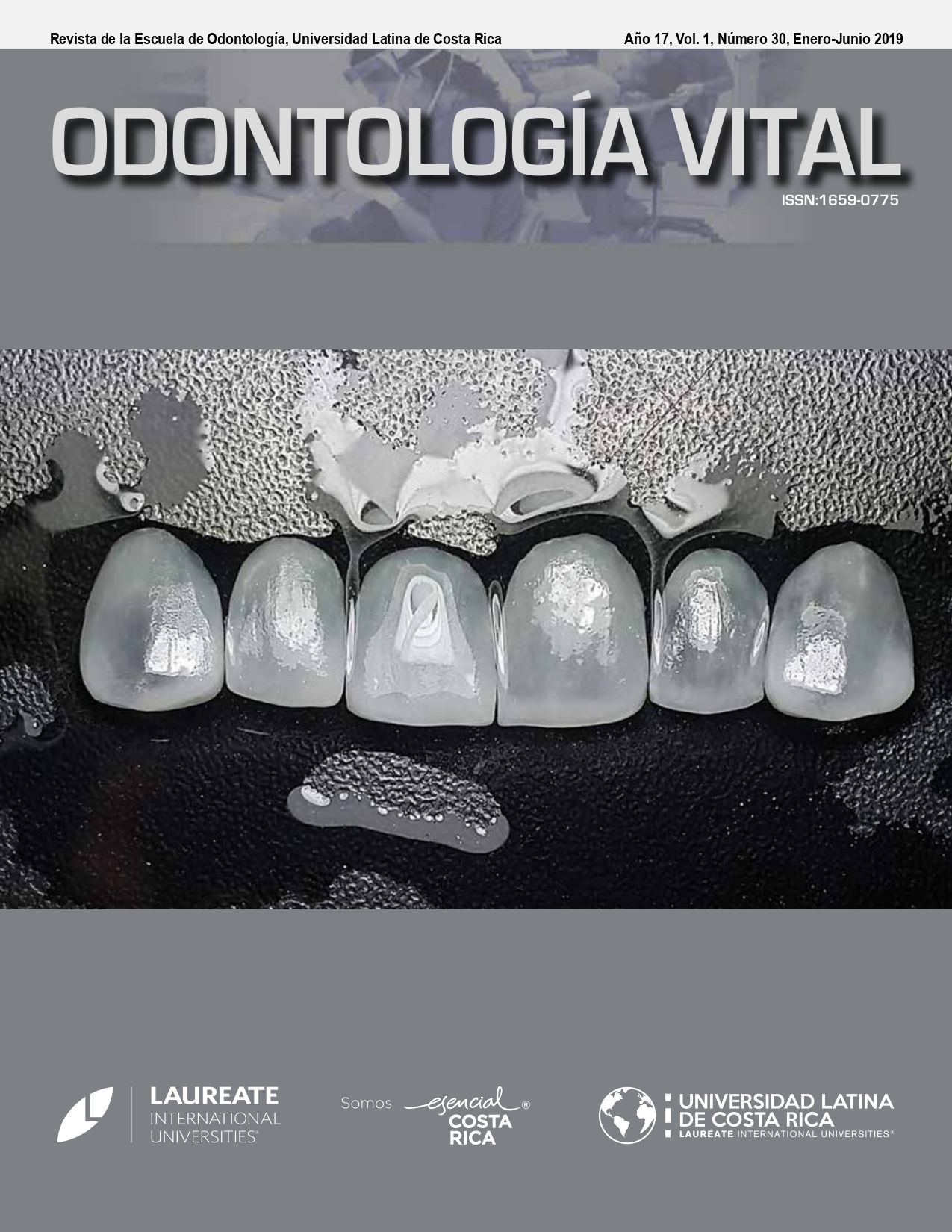Comparison of thickness and homogeneity of the cementation layer in indirect veneers, made with fluid resin vs. light-cure resin cement: in vitro study
DOI:
https://doi.org/10.59334/ROV.v1i30.139Keywords:
Flowable Resin, Cementation, Polymerization, Indirect VeneersAbstract
Objective: Compare the thickness and homogeneity of the cementing layer between a light-cure resin cement and a flowable resin.
Materials and methods: To obtain the sample, the preparation was carved in a replica of tooth 1.1 (EWL model teeth, Kavo), which was scanned and then replicated 92 times in an ABS polymer by 3D printing. The sample was divided into 2 groups with 46 samples each. The cementation of the veneers was performed with Tetric N-Flow flowable resin in the G1 group, and with Variolink Esthetic light-cure resin cement in the G2 group. Each sample was previously washed with 70° alcohol, then dried and a layer of Tetric N-Bond was applied. Digital pressure was used to achieve the final settlement of the veneers. Finally, a medial and a paramedial section were made to obtain approximately 2 mm thick samples. The cementation layer was observed with an optical microscope.
Results: The average thickness for Tetric N-Flow was 119μm in incisal, 113μm in medium and 107μm in cervical. For Variolink Esthetic the average was 117μm, 112μm and 110μm in incisal, middle and cervical respectively. The homogeneity was 93.3% for G1 and 91.3% for G2.
Conclusion: There is no significant difference in the thickness and homogeneity of the cementing layer made with flowable resin and with light-cure resin cement.
Downloads
References
Aranda N, Aizencop D, Ehrmantraut M. (2013). Comparación de la profundidad de fotopolimerización de resinas fluidas a través de 4 porcelanas de alta opacidad. Rev. Clin. Periodoncia Implantol. Rehabil. Oral ; 6: 123-126. https://doi.org/10.4067/S0719-01072013000300004
Díaz-Romeral, P.; Orejas Pérez, J.; López, E.; Veny, T. (2009). Cementado adhesivo de restauraciones totalmente cerámicas. Cient Dent ; 1:137- 151.
Freedman, G. (2012). Contemporary esthetic dentistry. Canada, Elsevier. 1° edición, Cap 16: 436 – 468. https://doi.org/10.1016/B978-0-323-06895-6.00041-4
Marghalani, H. (2012). Sorption and solubility characteristics of self adhesive resin cements. Dental materials 28: 187 – 198. https://doi.org/10.1016/j.dental.2012.04.037
Nguyen, J. Migonney, V. Dorin, N. Sadoun, M. (2012). Resine composite blocks via high-pressure high-temperature polymerization. Dental materials ; 28: 529 – 534. https://doi.org/10.1016/j.dental.2011.12.003
O. Sagsoz, N.Ilday, O. Karatas, M. Cayabatmaz, H. Parlak, M. Olmez, S. Demirbuga. (2016). The bond strength of highly filled flowable composites placed in two different configuration factors. Journal of Conservative Dentistry, 19: 21- 25. https://doi.org/10.4103/0972-0707.173188
P. Magne, U. Belser. (2004). Restauraciones de porcelana adherida en los dientes anteriores: método biomiméticos. Cap. 8, pág. 335 – 370.
P. Magne, U. Belser. (2004). Restauraciones de porcelana adherida en los dientes anteriores: método biomimético. Cap. 4, pág. 129-178.
Pavesi, N. Henrique, F. Alves, D. Lovadino, J. Sano, R. Correa, R. (2012). Advanced in dental veneres: materials, applications, and techniques. Clin Cosmet Investig Dent ; 4: 9 – 16. https://doi.org/10.2147/CCIDE.S7837
S. Nandini. (2010). Invited Review. Indirect resin composites. Journal of Conservative Dentistry ; 13: 184-194. https://doi.org/10.4103/0972-0707.73377
Sampaio, C. Barbosa, J. Cáceres, E. Rigo, L. Coelho, P. Bonfante, E. Hirata, R. (2017). Volumentric shrinkage and film thickness of cementation materials for veneers: An in vitro 3D microcomputed tomography analysis. The journal of prosthetic dentristry ; 117: 784 – 791. https://doi.org/10.1016/j.prosdent.2016.08.029
Samuelsson, R. Van Dijken, J. (2013). Microinvasive tooth preparation for bonded ceramic restorations. Am J Esthet Dent ; 3: 112 - 123. https://doi.org/10.11607/ajed.0061
Stamatacos, C. Simon, J. (2013). Cementation of indirect restorations: an overview of resin cements. Compendium of continuing education in dentistry Jour ; 34: 42 – 46.
Tirlet, G. Crescenzo, H. Crescenzo, D. Bazos, P. (2014). Creramic adhesive restorations and biomimetic dentistry: Tissue preservation and adhesion. The international journal of esthetic dentistry 9: 354 – 368.
Zenny, L. Pisani-Proenca, J. Guilherme, M. Andrade, F. Mieko, E. Del Castillo, R. (2008). Restauraciones indirectas de composite: conceptos generales y propuesta clínica de utilización. Quintessence publicación internacional de odontología 1: 1 – 7.
Downloads
Published
Issue
Section
License
Copyright (c) 2019 Carolina Manríquez, Francisca Tranamil, Pablo Vargas

This work is licensed under a Creative Commons Attribution 4.0 International License.
Authors who publish with Odontología Vital agree to the following terms:
- Authors retain the copyright and grant Universidad Latina de Costa Rica the right of first publication, with the work simultaneously licensed under a Creative Commons Attribution 4.0 International license (CC BY 4.0) that allows others to share the work with an acknowledgement of the work's authorship and initial publication in this journal.
- Authors are able to enter into separate, additional contractual arrangements for the non-exclusive distribution of the Odontología Vital's published version of the work (e.g., post it to an institutional repository or publish it in a book), with an acknowledgement of its initial publication.
- Authors are permitted and encouraged to post their work online (e.g., in institutional repositories or on their website) prior to and during the submission process, as it can lead to productive exchanges, as well as earlier and greater citation of published work.







